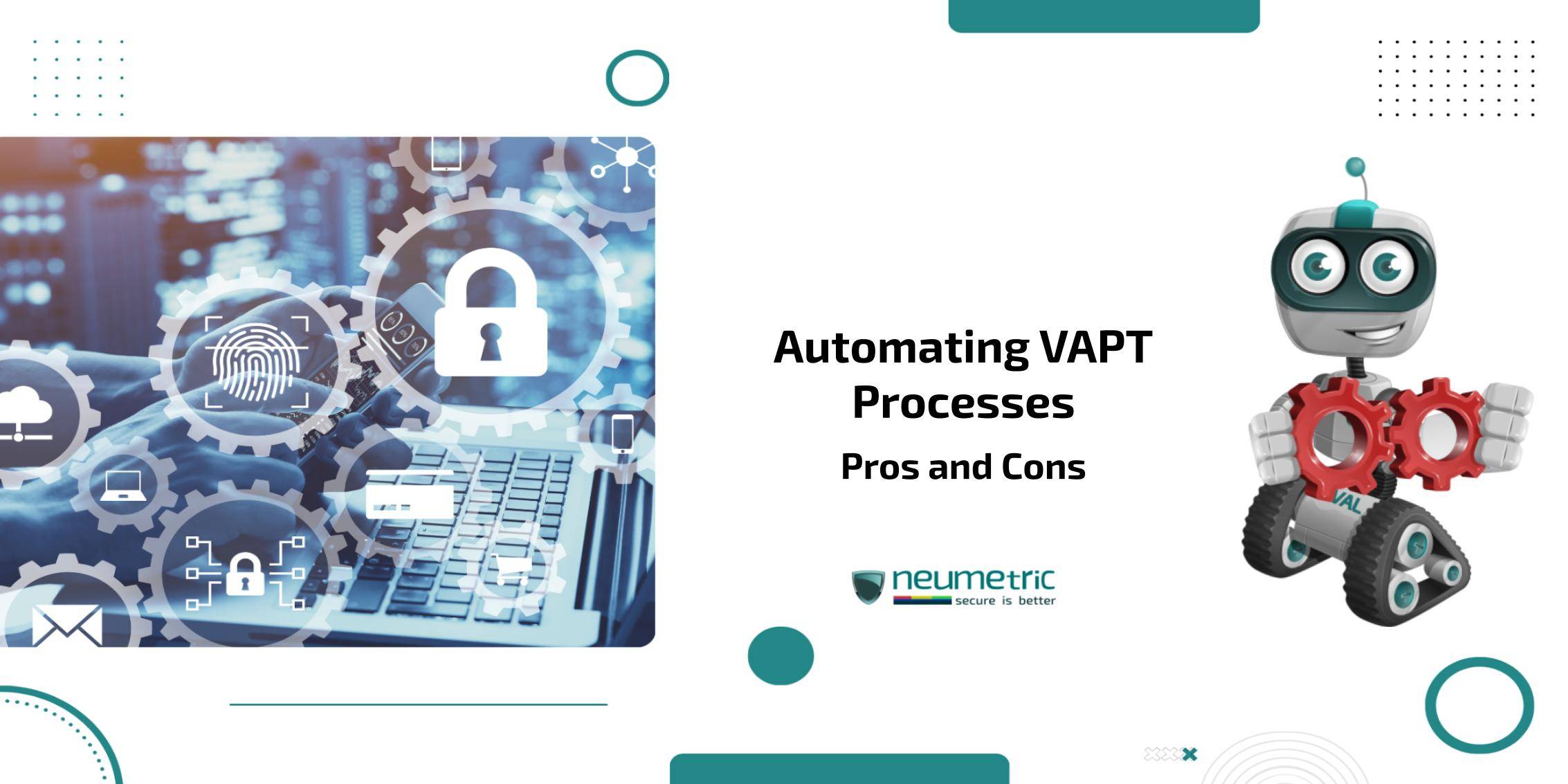Table of Contents
ToggleIntroduction
In the realm of cybersecurity, Vulnerability Assessment & Penetration Testing [VAPT] serve as the frontline defence against digital threats. This practice involves systematically identifying & addressing vulnerabilities within a system to fortify its security. With the ever-evolving nature of technology & associated risks, the integration of automation into VAPT processes has become a notable trend.
Automating VAPT processes introduces a paradigm shift by bringing speed, scalability & consistency to cybersecurity efforts. This automation expedites the detection & remediation of vulnerabilities, providing a swift response to emerging threats. It also allows security teams to focus on more complex tasks that demand human intuition, enhancing overall efficiency in safeguarding digital assets.
However, the integration of automation in VAPT processes is not without its challenges. While automation ensures rapid identification of vulnerabilities, there is a risk of overlooking nuanced aspects that human testers might catch, such as intricate social engineering tactics. Moreover, the sheer volume of automated results can overwhelm security teams, making it crucial to strike a balance between automated tools & human expertise. Achieving this equilibrium ensures a robust cybersecurity strategy that effectively leverages the strengths of both automation & human intuition, creating a comprehensive defence against a dynamic threat landscape.
The Case for Automating VAPT
In the rapidly evolving landscape of cybersecurity, automating Vulnerability Assessment & Penetration Testing [VAPT] processes has emerged as a game-changer, offering a multitude of advantages that transcend traditional manual approaches.
- Saves Time & Money:
Automating VAPT brings a dual benefit of speed & cost-effectiveness. When dealing with large-scale systems, automated tools can swiftly scan & identify vulnerabilities, significantly reducing the time required for assessments. This not only translates into cost savings but also ensures that security teams can keep pace with the dynamic nature of cyber threats.
Automated tools excel in handling repetitive tasks, mitigating the need for extensive manual effort. The speed at which they operate is unparalleled, covering more ground in a fraction of the time it would take for manual testing. This efficiency is particularly crucial in today’s digital landscape, where the sheer volume & complexity of systems demand a rapid & scalable approach to vulnerability detection.
- Improves Consistency & Eliminates Human Error:
Consistency is a cornerstone of effective cybersecurity & automation brings a standardised approach to VAPT processes. Automated tools follow predefined processes meticulously, reducing the chances of overlooking vulnerabilities due to human oversight. This not only enhances the accuracy of assessments but also minimises the risk of errors that can result from manual testing.
Furthermore, by removing the fatigue factor associated with manual testing, automation ensures that the accuracy & attention to detail remain high throughout the entire testing process. This is especially critical in scenarios where manual testers might experience burnout or overlook subtle vulnerabilities due to fatigue.
- Enables Continuous Testing:
Automation facilitates continuous testing, a crucial aspect in today’s fast-paced development environments. Automated tools can quickly adapt to frequent code changes, ensuring that vulnerabilities are identified & addressed promptly. This continuous testing approach is essential in preventing security gaps that may emerge as a result of frequent updates or modifications to software & systems.
Continuous testing also aligns with the agile development methodologies, where rapid iterations & updates are common. Automated VAPT processes seamlessly integrate into these workflows, providing real-time feedback on security vulnerabilities & allowing development teams to address issues proactively.
- Frees Up Staff for Higher Value Work:
By automating routine & repetitive tasks, security teams are liberated to focus on higher-value work that requires human expertise. Instead of spending time on routine tests, staff can concentrate on developing custom tests tailored to the specific needs of the organisation. Moreover, they can dedicate their efforts to interpreting results, devising strategic security measures & implementing proactive measures to safeguard against emerging threats.
The Concerns Around Automating VAPT
While the automation of Vulnerability Assessment & Penetration Testing [VAPT] processes brings notable benefits, it also raises concerns that warrant careful consideration. Acknowledging these concerns is crucial for organisations aiming to strike the right balance between leveraging automation & maintaining the efficacy of their cybersecurity measures.
- Potential for Lower Quality Tests:
One of the key concerns surrounding the automation of VAPT processes is the potential for lower quality tests. Automated tools, while efficient, may miss nuanced vulnerabilities that human testers can identify. Complex applications often require customised testing approaches that automated tools may struggle to adapt to. The challenge lies in ensuring that automated processes can replicate the depth & precision of manual testing, especially when dealing with intricate security nuances.
Customization becomes paramount in scenarios where off-the-shelf automated tools may not fully align with the unique intricacies of an organisation’s applications. The worry is that relying solely on automated tests may lead to a false sense of security, with critical vulnerabilities slipping through the automated checks.
- Increased Dependence on Tools:
The shift towards automation in VAPT processes raises concerns about increased dependence on tools. Over Reliance on automation can potentially result in the depreciation of manual skills within security teams. While automated tools excel in certain aspects, human intuition & expertise remain irreplaceable, particularly when dealing with sophisticated cyber threats that demand creative problem-solving & an understanding of context.
The danger here is that security professionals may become too reliant on automated outputs, potentially overlooking emerging threats that automated tools might not catch. Striking a balance between leveraging automation for efficiency & maintaining the skills of manual testing is essential to ensure a comprehensive & adaptive cybersecurity strategy.
- Higher Upfront Investment:
Implementing & integrating automated VAPT tools often comes with a higher upfront investment. Organisations need to allocate resources for the selection, implementation & integration of these tools into existing workflows. The time required to train staff on these tools & adapt existing processes can result in temporary disruptions. Additionally, ongoing maintenance overhead adds to the cost, as tools need to be regularly updated to address new threats & vulnerabilities.
While the long-term benefits in terms of efficiency & effectiveness are substantial, the initial investment can be a deterrent for some organisations, especially those with limited resources. It becomes imperative to weigh the upfront costs against the anticipated long-term gains & improved security posture.
- Results Require Human Verification:
Despite the advancements in automated VAPT tools, results still necessitate human verification. Manual review is essential to validate & interpret the findings in a business context. Understanding the implications of vulnerabilities, assessing the level of risk they pose & devising strategic remediation plans require human expertise. The challenge lies in ensuring that automated outputs are not blindly accepted & there is a robust process in place for human verification to enhance the accuracy & relevance of the results.
Best Practices for Implementation
Implementing automation in Vulnerability Assessment & Penetration Testing [VAPT] processes requires a strategic & gradual approach to ensure seamless integration & optimal results. Here are some best practices to consider when embarking on the journey of automating VAPT:
- Phase in Gradually, Starting with a Pilot:
Rather than diving headfirst into full-scale automation, a phased approach starting with a pilot program is a prudent strategy. This allows the organisation to learn & understand the intricacies of the automated processes before applying them at scale. During this pilot phase, teams can identify potential challenges, fine-tune the tools & establish frameworks for future expansion. This iterative process helps build confidence in the efficacy of automated VAPT tools & ensures a smoother transition when scaling up.
- Maintain Skilled Staff for Oversight:
While automation enhances efficiency, the role of skilled human oversight is indispensable. Organisations should maintain a team of knowledgeable professionals who can govern the use of automated tools. This involves setting guidelines, ensuring ethical considerations & tuning tools & analysis to suit the specific environment. Skilled staff can interpret the results in a business context, making informed decisions about the severity of vulnerabilities & the most appropriate remediation strategies.
- Focus Automation on Commoditized Tasks:
Automation is most effective when applied to commoditized tasks that are routine & repetitive. Standard vulnerability scans, for instance, can be efficiently automated, allowing the team to allocate more time & effort to addressing complex security issues. For custom applications or intricate systems, it is advisable to reserve manual testing, where human intuition & adaptability play a crucial role. This targeted approach ensures that automation complements human capabilities, providing the best of both worlds.
- Use Automation to Augment Existing Processes:
Rather than replacing existing processes, automation should be viewed as a tool to augment & enhance them. By automating repetitive manual tasks, such as routine scans & basic vulnerability assessments, security teams can free up valuable time & resources. This not only increases efficiency but also retains flexibility for the incorporation of new techniques & methodologies. The goal is to strike a harmonious balance where automation streamlines routine tasks, allowing human expertise to focus on more intricate aspects of VAPT.
Conclusion
In conclusion, the automation of Vulnerability Assessment & Penetration Testing [VAPT] processes introduces a spectrum of advantages & risks that necessitate careful management. While the efficiency gains & rapid response to threats are compelling, there’s a critical need for organisations to remain vigilant against potential downsides, such as overlooking nuanced vulnerabilities & the risk of over-reliance on automated tools.
Following best practices becomes paramount in this dynamic landscape. By gradually implementing automation, maintaining skilled human oversight, focusing on commoditized tasks & using automation as a supplement rather than a replacement for existing processes, organisations can maximise the benefits of automated VAPT. This approach ensures that efficiency gains are realised without sacrificing the meticulous attention & adaptability that human expertise brings to the realm of cybersecurity.
FAQ
- Why should organisations consider automating VAPT processes & what benefits does it bring?
Organisations should consider automating VAPT processes because it significantly enhances their cybersecurity defences. Automation saves time & money by swiftly identifying vulnerabilities at scale, reduces manual effort & ensures a rapid response to emerging threats. Additionally, it improves consistency, eliminates human error & enables continuous testing, crucial in today’s fast-paced digital landscape.
- What are the main concerns associated with automating VAPT & how can they be mitigated?
While automating VAPT processes offers efficiency gains, concerns include potential lower quality tests, increased dependence on tools, higher upfront investment & the need for human verification of results. To mitigate these concerns, organisations should phase in automation gradually, maintain skilled staff for oversight, focus automation on commoditized tasks & use automation to augment existing processes while retaining flexibility for new techniques.
- What are the best practices for implementing automated VAPT & how can organisations ensure a balanced approach?
Best practices for implementing automated VAPT include phasing in gradually with a pilot program, maintaining skilled staff for oversight, focusing automation on commoditized tasks & using automation to augment existing processes. A balanced approach involves learning from the pilot phase, establishing frameworks for expansion, governing tool use with human expertise & ensuring that automation complements rather than replaces existing manual processes. This ensures organisations harness the benefits of automation without compromising the quality of their cybersecurity measures.





